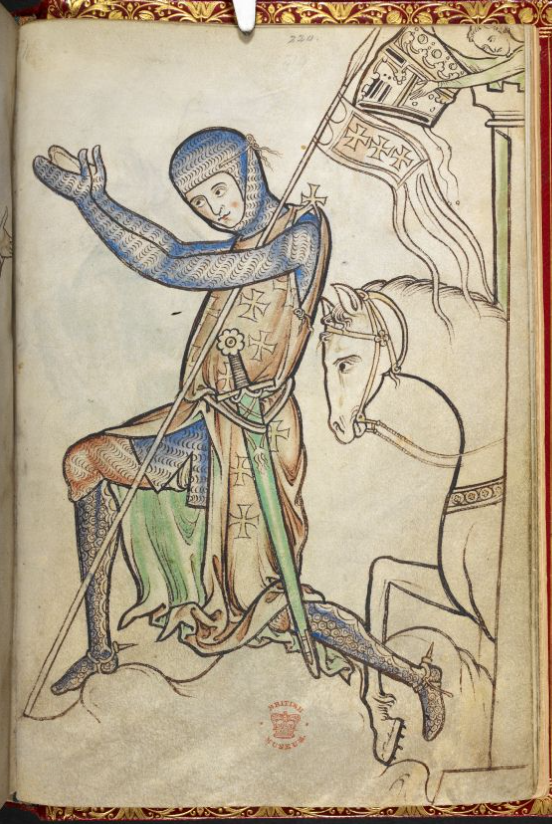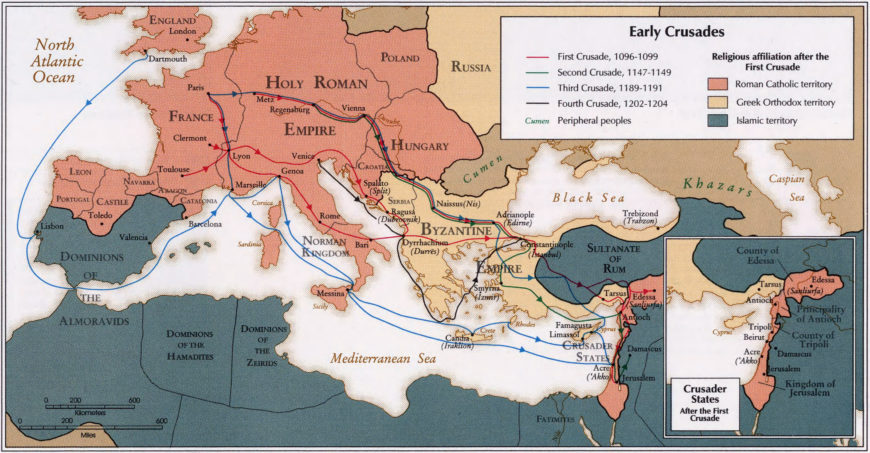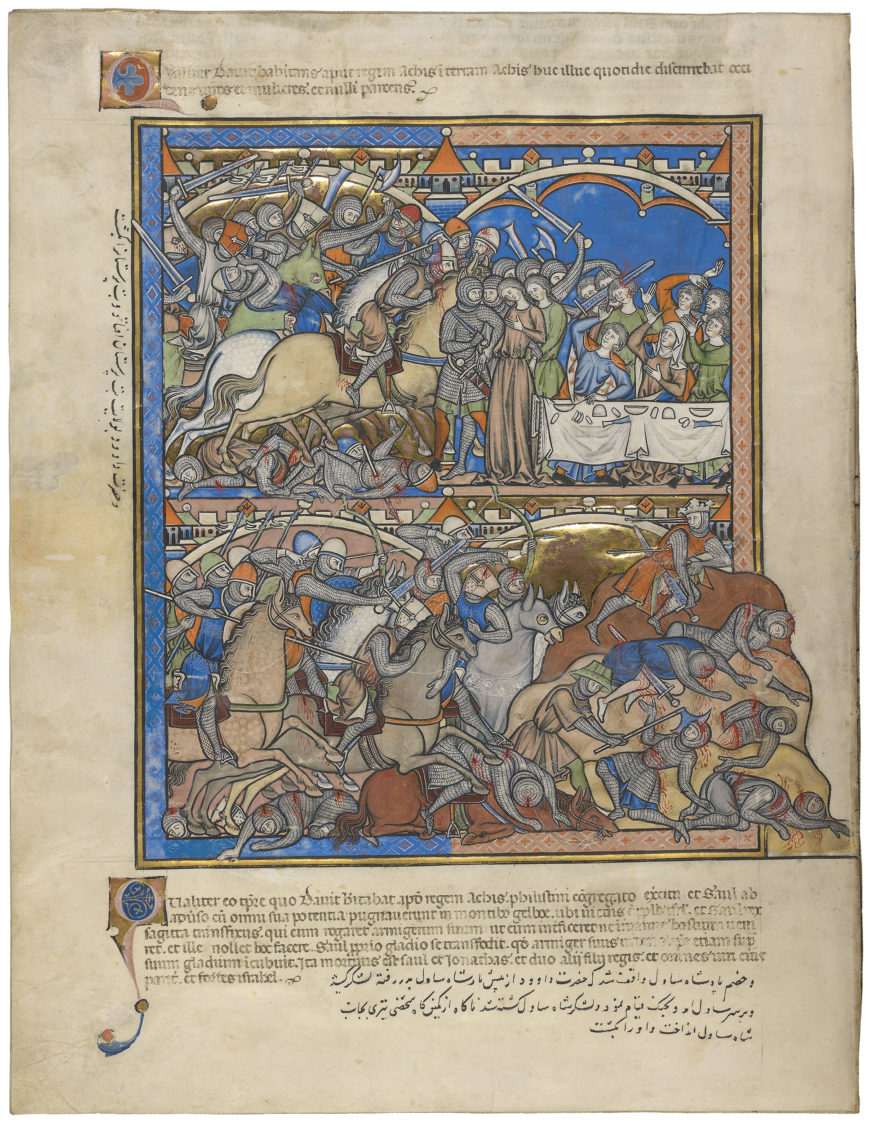
Crusader, Psalter, with litany, prayers and Easter tables (The “Westminster Psalter”), c. 1200, f. 220 (British Library)
What comes to mind when you think of the crusades? Earnest and alarmingly buff knights (in shining armor, of course) engaged in against-the-odds quests to accomplish godly deeds in an evil world? Red crosses on pure white backgrounds? Orlando Bloom?
This is not surprising. A quick look at our pop culture and politics in the West reveals a continued fascination with the crusades. Compared with popular representations, the historical reality is more complicated and often less heroic.
How do we define the crusades?
Imagine a man-at-arms in the French city of Clermont in 1095. He is listening to Pope Urban II—the only pope he has ever seen in person!—speak passionately about the need to fight in the Holy Land. His lord is persuaded, and gathers his men and resources. The man-at-arms says goodbye to his family, and departs in 1096 on years of painful journeying and military campaigns. He dies of starvation at Antioch, never seeing Jerusalem. His family never knows his fate. This was crusading.
Now imagine Frederick II, Holy Roman Emperor and King of Sicily. Frederick regains Jerusalem from the Muslims without waging war—it helps that he knows Arabic. He is crowned the King of Jerusalem in 1229, but returns to Europe to find the pope waging war on his lands. This, too, was crusading—at least it was for some, though others, like the pope, disagreed.
Finally, imagine an English knight in 1370. He plans to travel to northeastern Europe to fight non-Christians and help Christians there expand their territory. He will go for a season, enjoy feasting and knightly camaraderie, then return home and go back to his regular life, with his reputation enhanced by his trip. You guessed it: this was also crusading.
Crusading took many different forms, and attempting to precisely define crusading has engaged historians in intense debates for more than 150 years.

Map with the First through Fourth Crusades, from Atlas of the Middle East (Central Intelligence Agency, 1993)
Scholarly debates
Most of the debates among scholars are concerned with identifying the key characteristics of a crusade. Some, for example, consider only expeditions aimed at Jerusalem or the Holy Land to be crusades. This approach is responsible for the traditional, numbered crusades (i.e., First Crusade, Second Crusade, etc.).
Others downplay the importance of a specific target, and emphasize instead characteristics related to authorization and procedure. These scholars would ask, did a pope authorize the expedition? Did participants take vows and receive certain legal and spiritual privileges? Taking this approach yields a larger number of crusades, spread over a larger geographical area and chronological range. At the same time, some question whether the role of authorities (i.e, the pope) determined a crusade as much as grassroots enthusiasm among ordinary people. These scholars would look, instead, for signs of mass popular support for an expedition. Still others assert that the characteristics of crusading were so diffuse throughout medieval culture that it is impossible and ultimately misleading to attempt to define what was or was not a crusade.
It is also fair to say that many scholars recognize that one can spend too much time seeking a meticulous definition, in essence missing the forest for the trees!

The biblical story of the slaughter of the Amalekites and King Saul’s last stand with the biblical soldiers depicted as French Crusaders, Crusader Bible, fol. 34v, 1244–54, Paris (The Morgan Library and Museum, New York)
Outward signs
If crusading was so nebulous, how did potential participants know what a crusade was? Remember our man-at-arms in Clermont in 1095? He (and his lord) noticed preaching for a new expedition (perhaps emphasizing a papal proclamation, perhaps not), or heard people around him discussing it. Perhaps he also saw others taking public vows and wearing the sign of the cross on their garments. He may have learned of certain legal privileges designed to encourage participation and help protect property and families in the crusader’s absence. Or perhaps he heard of a papal promise of an indulgence (“indulgence” in this context simply means a spiritual benefit of some kind—the precise kind of indulgence offered for crusading changed over time).
Finally, our man-at-arms was interested in crusading, but for others, someone with authority over them (or someone they loved), may simply have told them it was happening or that they were going. Much like today, some people may have simply paid attention to their taxes; at times, especially in the later Middle Ages, both the Church and secular authorities levied funds for new expeditions. Any or all of these factors may have caught people’s attention, especially if they came from a family or region with a tradition of crusade participation. Meanwhile, for those who were the targets of crusader violence, presumably the only sign needed was the sight of an approaching army bedecked with crosses.
Different points of view
While it’s valuable to seek to understand the crusades from the perspective of participants, it’s equally important to seek out different points of view. Internal criticism of the crusading movement was more limited than many today might expect. What criticisms existed were usually leveled at specific expeditions or participants, rather than at the idea of crusading in general or the underlying attitudes towards religion and violence that made crusading possible.
Muslim voices, whether in the Iberian Peninsula (what is now Spain and Portugal), the Levant (the eastern Mediterranean), or further afield, described the crusades in different ways—often as simple territorial expansion, religious warfare, or a combination of the two. Descriptions of the “Franks” themselves (as the crusaders were called) ranged from respect to ridicule to hostility.
Records from Jewish communities around the Mediterranean sometimes described an undiscriminating ferocity and zealous fervor held by many crusaders, a theme also underlined by Christians within Europe who did not conform to Church teachings, and thus were called “heretics.” Some accounts of the crusades from the Byzantine Empire (a medieval state based on the remains of the classical Roman Empire) emphasized the purported “barbarity” and relative naivete of the crusaders.
Additional resources
The when, where and who (of crusading).
Dr. Susanna A. Throop, The Crusades: An Epitome (Leeds: Kismet Press, 2018), an open access book.
Dr. Ariel Fein, “Material culture of the Crusades,” Reframing Art History, 2022.
The Crusades on The Metropolitan Museum of Art’s Heilbrunn Timeline of Art History.

